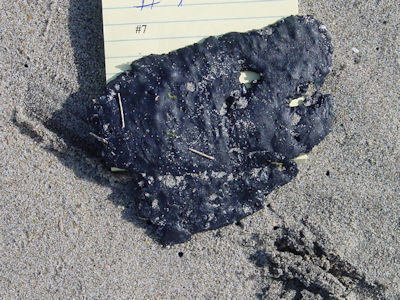Tarballs and Weathering
Tarballs are the little, dark-colored pieces of oil that can sometimes stick to your feet when you go to the beach and they are actually remnants of oil spills. When crude oil (or a heavier refined product) floats on the ocean surface, its physical characteristics change.
- During the first few hours of a spill, the oil spreads into a thin slick.
- Winds and waves tear the slick into smaller patches that are scattered over a much wider area.
- Various physical, chemical, and biological processes change the appearance of the oil.

These processes are generally called "weathering." Weathering processes eventually create tarballs that is hard and crusty on the outside and soft and gooey on the inside, not unlike a toasted marshmallow.
Tarballs are very persistent in the marine environment and can travel hundreds of miles. There is no magic trick to making tarballs disappear. Once tarballs hit the beaches, they may be picked up by hand or by beach-cleaning machinery. If the impact is severe, the top layer of sand containing the tarballs may be removed and replaced with clean sand.
Knowledge Check Choose the best answer for the question.
2-8. What is the process involved with the creation of tarballs generally called?
You forgot to answer the question!
